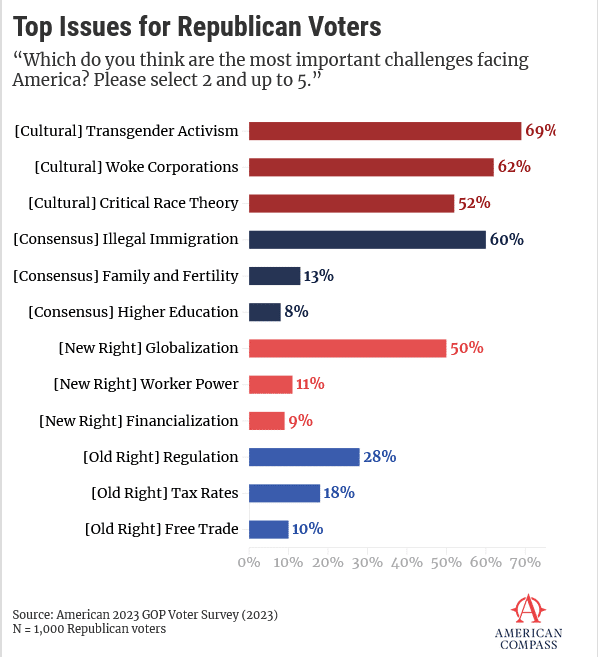October 2, 2023
Permission to republish original opeds and cartoons granted.
The New Right Cares About More than Taxes – and That Makes it More Powerful

By Rick Manning
New research is challenging assumptions about the Republican Party’s core values, showing the GOP of the 2020s is an entirely different animal from the GOP of the 2010s. The research captures an increasing shift toward populism and America First priorities that has been growing since Former President Trump’s election in 2016.
The study by American Compass divides Republicans into two camps, the Old Right and the New Right, based on their economic priorities and approach to cultural issues.
Old guard conservatives are a dwindling share of the Republican movement, with New Right populists significantly outnumbering them according to the American Compass survey. Just 29% of Republicans fall into the Old Right, 28% are “neutral”, and 42% of Republicans embrace the New Right’s focus on addressing issues like globalization, financial disempowerment, and worker’s rights.
The Old Right is focused primarily on cutting taxes and reducing spending, while the New Right is focused on restoring power to American workers, bringing manufacturing back to the U.S., and actively combatting a Marxist cultural agenda.
To understand modern conservative dissidents, understanding the Tea Paty movement of 2008 and it’s distinctly libertarian focus on fiscal issues with a laissez-faire, “don’t tread on me” approach to cultural issues is important.
This research comes fifteen years after the Tea Party movement emerged as the primary challenger of the “traditional” GOP, calling out wasteful spending and government overreach on both sides of the aisle.
Americans for Limited Government recognized early on that America’s descent could not be stemmed by tax cuts and fewer regulations alone. This is why we led the fight to stop globalization of our economy by opposing the fast tracking of Barack Obama’s TransPacific Partnership. The hollowing out of our manufacturing base and dependency on China and others who view America as enemies posed and continues to pose an existential threat to our nation’s survival. Now, this position is mainstreamed with GOP voters.
On the immigration front, the open borders policy of the left (for votes) and corporate America (for cheap labor) is untenable and an attack on our national right to exist as a sovereign nation.
This is why the New Right isn’t so much opposed to the principles of the Tea Party – tackling wasteful spending and cutting taxes – as it is less singularly fixated on those issues. Modern conservatives see their duty as much more all-encompassing and refuse to shy away from thorny cultural issues. The New Right also has a distinctly pro-worker approach to economic issues and believes the government should act on behalf of American workers.
A full 90% of Republicans say middle-class life has gotten harder in the past few years and wages have not kept up to support working class families. In a blow to big corporations, a full 85% of Republicans say companies complaining about labor shortages is a good thing, because it will incentivize them to raise wages for American workers. This is a much more populist view of labor, but perhaps a more rational one.
And every GOP candidate for president should be thankful that President Trump focused upon increasing income for American workers while keeping inflation low. The result is that people from all ethnicities recognize that they were better off under Trump than Biden, as real income under the GOP president rose by more than $6000 in four years, while it has shrunk by $4000 under Biden.
This shift is hard for some old line GOP self-proclaimed ‘thought-leaders’ to take, as the research found that 77% of Republicans support tariffs to bolster manufacturing and 78% say the government should support U.S. made products in advanced technologies like semiconductors. These positions put America First, rather than encouraging dependence on foreign countries and lining the pockets of foreign companies.
Eight years ago, even thinking about the idea that tariffs might be a useful tool in changing international dependencies and increasing the capacity of our domestic manufacturing sector was poison for a conservative group. Tackling the real life problem that American citizens who were busting their tails to make a living and take care of their families were being harmed by policies that actively encouraged the wholesale shifting of industries overseas was seen as a fool’s errand likely to end a conservative’s career.
But we didn’t care. Sometimes you just need to do what is right, regardless of fall-out.
The research shows that today, the most important economic issue to conservatives is addressing the harm of globalization, with 50% of Republicans citing globalization as a priority. Meanwhile, 28% and 18% prioritize addressing regulation and tax rates, top priorities of the Tea Party movement.
Americans for Limited Government is in the middle of the fight for lowering taxes, killing regulations that are outside of the law and kill our economic freedom, and unwinding the out of control globalism that has exported our wealth to countries who want to end our freedom.
Conservatives now demand that their leaders address the far-left’s attempt to force anti-science propaganda into the culture through the transgender movement is the number one priority for conservatives according to the research. Nearly 70% of Republicans cite transgender activism as the most important issue to be addressed. Other cultural issues like addressing woke corporations (62%) and Critical Race Theory (52%) are high on the list of priorities, as is addressing illegal immigration (60%).
The GOP presidential contenders would be wise to adapt to the fact that conservatives are now as vocal about removing the trans agenda from public schools, securing the border, and actively bolstering opportunities for the middle class as they are on cutting wasteful spending and lowering taxes.

The Gadsen flag with its coiled snake baring the phrase, “don’t tread on me” become a symbol of the Tea Party dissidents in the 2010s, demanding smaller, less-invasive government. The problem is, we were tread on.
Globalization rapidly accelerated and destroyed entire sectors of the U.S. economy, while lining the pockets of the uber-wealthy. Americans watched as millions of illegals flooded into the country, driving down wages for citizens and straining our social safety nets. A ubiquitous social agenda has reduced acknowledging basic biology to “hate speech”, and children are being indoctrinated to despise themselves and their country.
The new rallying cry, “Make America Great Again”, is an unapologetic demand that those in power address the entirety of the American system, including globalism and cultural rot, or pay the price at the ballot box.
And that is the point, the people are far ahead of those who ask to lead them on many of these issues, and if those leaders don’t catch up, they will have the relevance of Harold Stassen in future presidential contests.
The world has changed. Tired talking points no longer excite as they are less relevant to the everyday lives of conservative voters.
This is great news politically as the New Right is more empowered to address a wide spectrum of issues including the disastrous impact of globalization and radical ideas on gender. This new construct paves the way to a permanent realignment that leaves those who would throw America on the dustbin of history on the sidelines for at least a generation.
The New Right has a right to expect their elected officials will stand up and fight. And if they won’t, those who think they are leaders will find themselves discarded and confused by what went wrong.
We have a country to save, and time has run out on those who offer tired platitudes which no longer are relevant to 21st century America. It is time for those who claim the mantle of leadership to lead or get out of the way.
As the modern left has moved farther and farther away from reality, unleashing a categorically unhinged agenda onto the rest of us, GOP political leaders can no longer ignore the problems caused by globalization and duck the culture war and expect to politically survive.
And those who argue otherwise, simply are not paying attention.
Rick Manning is the President of Americans for Limited Government Foundation.
To view online: https://dailytorch.com/2023/09/the-new-right-cares-about-more-than-taxes-and-that-makes-it-more-powerful/
45-day continuing resolution sets stage for year-end fight over omnibus—again

By Robert Romano
Sept. 30 has come and gone as fiscal year 2023 has ended, but without an agreement from Congress on appropriations for the $1.7 trillion so-called “discretionary” budget, resulting in a 45-day continuing resolution that will continue to fund the government at 2023 levels, give or take, until Congress later hammers out a more permanent agreement.
What else is new?
This is what usually happens every year, regardless of which party is in power, with some variation: the fiscal year will be coming to an end and, with or without a government shutdown, eventually Congress will pass a continuing resolution for a month or two, as the appropriations committees in the House and Senate hammer out a year-end omnibus spending bill or continuing resolution.
In fact, since 1977, Congress has completed all of its appropriations bills — now 12 — only four times prior to Oct. 1: in 1977, 1989, 1995 and 1997. The last time no continuing resolution was used by Congress was in 1997. Otherwise, Congress typically does not get the appropriations process done, about 91.3 percent of the time, instead resorting to stopgap spending bills in lieu of a massive omnibus or year-long continuing resolution.
The gridlock is by design, with the Constitution providing for a bicameral legislature that often is composed of opposing parties who must find agreement with the President, who also might be of a different party, for any bill including appropriations to become law. Situations of there being mixed party rule occurred most of the time since 1977, 66 percent of the time, whereas only 33 percent of the time was there one-party control of the House, Senate and White House, 1977 through 1980, 1993 through 1994, 2003 through 2006, 2009 through 2010, 2017 through 2018 and 2021 through 2022.
Ironically, three out of four times that Congress got all of its appropriations bills done prior to Oct. 1 came with mixed party situations, where one party controlled the White House and the other controlled the House and Senate. In 1989, Republican George H.W. Bush came to agreement on funding bills with a Democratic controlled Congress, and in 1995 and 1997 Democrat Bill Clinton came to an agreement on spending bills with a Republican controlled Congress. In 1977, it was done with Democratic one-party rule, but that appears to be the exception.
Otherwise, the government has been funded for at least part of the year via continuing resolutions in 42 out of 46 years since 1977. These usually result in omnibus spending bills — with 29 omnibus spending bills adopted since 1986, and 15 full-year continuing resolutions since 1977 — highlighting Congress’ usual practice of combining all of the spending into one or two bills and passing them that way, rather than the supposed “traditional” 12 appropriations bills that almost always never get all done.
The other certainty is that Congress will eventually end any temporary disagreement over keeping the government funded through government shutdowns — there have been 22 shutdowns since 1976 — with the longest shutdown occurring for 35 days in 2018 and early 2019. The second longest shutdown was in 1995 and 1996 of 21 days.
Therefore, the gridlock and disagreement surrounding funding bills — and the occasional government shutdown — is not the exception, but rather the rule to expect in Washington, D.C., regardless of which parties are in power. And again, that is by design. With Congressional elections every two years, plus the bicameral constitution of Congress, and therefore the high likelihood of mixed government, the odds are almost always greater that there will be no agreement on spending. It’s supposed to be hard.
And the outcomes, with only minimal changes to baseline spending occurring, for example in 2011 and 2023 spending deals that created budget sequestration, should not be that surprising. With very little agreement about how to deal with the spending Congress has the most control over, there is even less agreement about what to do about the auto-pilot so-called “mandatory” spending — Social Security, Medicare, Medicaid, interest on the debt and so forth — that occurs whether Congress does anything or not.
Without any significant changes to baseline spending, particularly with Social Security and Medicare growing by leaps and bounds this decade amid the Baby Boomer retirement wave, as a result, the Office of Management and Budget projects that by 2033, the national debt will be over $50 trillion, and that might be a low ball.
In truth it could be much larger than that, since the debt has been growing at more than 8 percent a year on average since 1980. In fact, if it continues at its current clip, it will rise to more than $100 trillion by 2037, a potential reckoning and yet, one that appears no more likely to foster agreement among the parties in Congress over what to do about it, no matter how bad it gets. Stay tuned.
Robert Romano is the Vice President of Public Policy at Americans for Limited Government Foundation.
To view online: https://dailytorch.com/2023/10/45-day-continuing-resolution-sets-stage-for-year-end-fight-over-omnibus-again/
Video: A Time For Yes

To view online: https://www.youtube.com/watch?v=C2LyZ4XYqRo

![]()
Rebecca Kern and Josh Gerstein: Supreme Court will review GOP-led social media laws in Texas, Florida
By Rebecca Kern and Josh Gerstein
The political fight over speech on social media is officially heading to the Supreme Court.
On Friday, the justices said they will take up two cases that have become flashpoints for the argument over Big Tech’s efforts to police speech online. The cases challenge Florida and Texas laws, where Republican-led legislatures have told social media companies they can’t remove content based on users’ viewpoints and can’t ban politicians, like former President Donald Trump, from the platforms.
Two federal courts have already ruled in different ways on this: The 5th U.S. Circuit Court of Appeals upheld the Texas law, while the 11th Circuit found Florida’s largely violated the First Amendment. The 11th Circuit did uphold a key provision requiring companies to clearly post their content moderation rules.
The Republican-led Texas and Florida laws are reactions to the power that lawmakers say social media platforms have over political discourse online, with conservatives claiming their content gets disproportionately removed compared with their left-leaning counterparts. The laws came in the wake of the 2020 presidential election, when major platforms banned Trump for violating their policies against incitement of violence related to his posts during the Jan. 6, 2021, insurrection at the U.S. Capitol.
The cases likely won’t be heard until next year, and both laws are currently blocked from going into effect. Texas’ law restricts social media sites from removing content based on users’ viewpoints and Florida’s law stops platforms from banning politicians and candidates from their services.
The cases were brought by two tech lobbying groups: NetChoice and Computer and Communications Industry Association, which represent social platforms like Meta and Google. They claim the laws violate platforms’ First Amendment rights to moderate and edit content on their sites, meaning they would be forced to allow speech that violates their own policies against violent and extremist content.
The court limited its consideration of the cases to the laws’ restrictions on the platforms’ content-moderation policies and requirements to notify users when their posts are taken down. The justices won’t address whether the laws targeted the companies because they discriminated based on political views or whether the laws’ requirements for companies to publish their content moderation rules violate companies’ free speech rights.
Chris Marchese, NetChoice’s litigation director, said social media companies have a First Amendment right to host, curate and share content as they see fit. “The internet is a vital platform for free expression, and it must remain free from government censorship,” he said in a statement.
Similarly, CCIA President Matt Schruers, said in a statement that “telling private websites they must give equal treatment to extremist hate isn’t just unwise, it is unconstitutional, and we look forward to demonstrating that to the Court.”
A spokesperson for Florida said the state looks forward to defending its law at the Supreme Court. The offices of Texas Attorney General Ken Paxton did not immediately respond to a request for comment.
To view online: https://www.politico.com/news/2023/09/29/supreme-court-to-hear-challenges-to-state-social-media-laws-00119051

